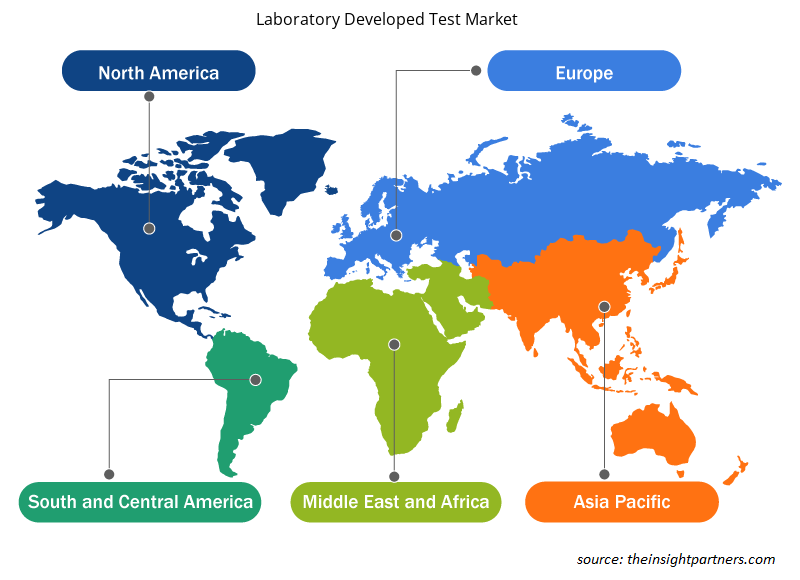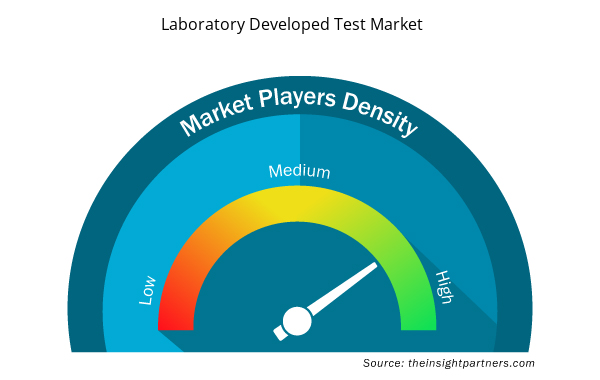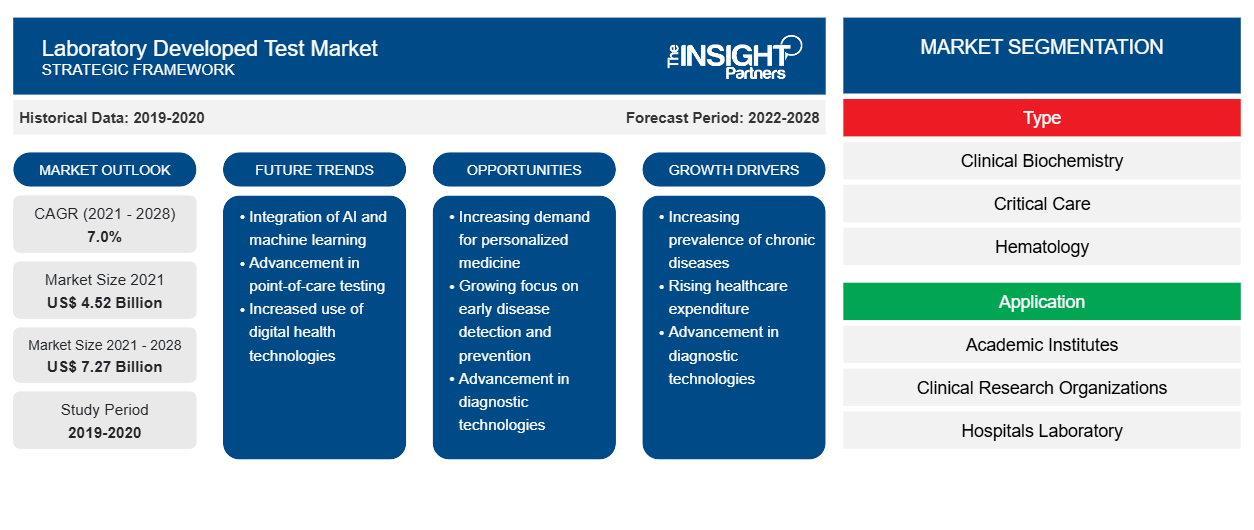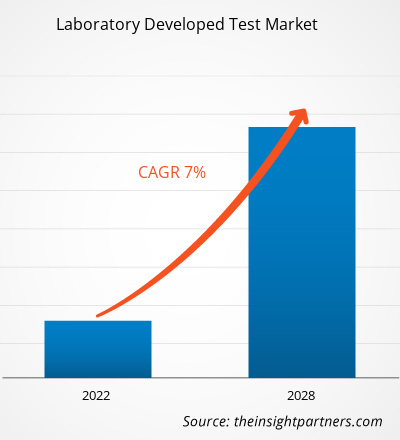실험실에서 개발된 시험 시장은 2021년 45억 2,475만 달러에서 2028년에는 72억 6,930만 달러에 도달할 것으로 예상되며, 2021~2028년 동안 연평균 성장률 7.0%로 성장할 것으로 예상됩니다.
실험실 개발 검사(LDT)는 단일 실험실 내에서 설계 및 사용되는 일종의 체외 진단 검사입니다. 이러한 검사는 단백질, 생체 분자/화합물(포도당, 콜레스테롤 등), 인간 피험자로부터 수집한 표본에서 추출한 DNA와 같은 분석물을 추정하거나 구별하는 데 사용할 수 있습니다. 정확하고 오류 없는 분석을 제공하기 위해 실험실 및 약국을 위한 자동화된 체외 진단(IVD) 방법의 확대는 실험실 개발 검사 시장 성장을 촉진하고 있습니다.
실험실에서 개발된 테스트 시장 의 성장은 주로 암과 유전적 질환의 증가와 많은 수의 제품 출시와 같은 요인에 기인합니다. 그러나 규제 환경의 변화는 시장 성장을 방해하고 있습니다. 예를 들어, 유럽에서는 2022년 5월부터 모든 체외 진단 검사에 체외 장치 규정(IVDR) 준수가 의무화됩니다. 이 규정은 의료 검사의 임상적 효과와 안전성을 확보하여 진단 산업을 혁신하는 것을 목표로 하며, 이는 시장 참여자에게 큰 관심사입니다.
귀하의 요구 사항에 맞게 이 보고서를 사용자 정의하세요
이 보고서의 일부 또는 국가 수준 분석, Excel 데이터 팩을 포함하여 모든 보고서에 대한 사용자 정의를 무료로 받을 수 있으며 신생 기업 및 대학을 위한 훌륭한 혜택과 할인 혜택을 이용할 수 있습니다.
- 이 보고서의 주요 시장 동향을 알아보세요.이 무료 샘플에는 시장 동향부터 추정 및 예측까지 다양한 데이터 분석이 포함됩니다.
시장 통찰력
개인화된 의약품에 대한 지속적인 연구는 실험실에서 개발된 테스트 시장 참여자에게 성장 기회를 제공합니다.
LDT는 효과적인 치료법이나 완치법을 통해 질병을 해결하는 유망한 수단으로 입증될 가능성이 있는 개인화된 의약품 개발에 중요한 역할을 합니다. Personalized Medicine Coalition에 따르면, 개인화된 의약품은 2005년에 FDA 승인을 받은 새로운 분자 엔티티의 5%에 불과했지만, 2016년에는 이 숫자가 25% 이상으로 증가했습니다. 또한, 파이프라인에 있는 모든 화합물의 42%와 종양학 화합물의 73%는 개인화된 의약품으로 사용될 수 있는 잠재력이 있습니다. 생물제약 회사는 지난 5년 동안 개인화된 의약품에 대한 R&D 투자를 거의 두 배로 늘렸으며, 향후 5년 동안 투자를 33% 늘릴 것으로 예상됩니다. 생물제약 연구원들은 또한 향후 5년 동안 개인화된 의약품 개발이 69% 증가할 것으로 예측합니다. 실험실 검사는 질병을 진단하고 약물 반응을 예측 및 모니터링하는 데 사용되며, 복잡한 예측 알고리즘에 필요한 정보 데이터를 얻는 데에도 사용됩니다. play a vital role in the development of personalized medicines that are likely to prove as promising means of tackling diseases through far eluded effective treatments or cures. As per the Personalized Medicine Coalition, personalized medicines accounted for only 5% of the new FDA-approved molecular entities in 2005; however, in 2016, this number rose to more than 25%. Additionally, 42% of all compounds and 73% of oncology compounds in the pipeline have the potential to serve as personalized medicines. Biopharmaceutical companies have nearly doubled their R&D investments in personalized drugs in the last five years, and they are further expected to increase their investments by 33% in the next five years. Biopharmaceutical researchers also predict a 69% increase in the development of personalized medicines in the next five years. Laboratory tests are used to diagnose illness and predict and monitor drug response as well as to obtain informatics data needed for complex predictive algorithms.
개인화된 의약품은 암 치료의 상표가 되고 있습니다. 이는 개인의 유전적 구성에 따른 치료법의 맞춤화를 기반으로 하는 끊임없이 진화하는 접근 방식입니다. 2019년 FDA는 질병의 근본 원인을 조사하고 해결하기 위해 12가지 개인화된 의약품을 승인하여 임상 치료에 정밀 의학을 결합했습니다. 개인화된 의약품에 대한 수요가 증가함에 따라 실험실에서 개발된 시험 시장에서 활동하는 업체의 성장에 상당한 성장 기회가 제공되고 있습니다.
유형 기반 통찰력
실험실에서 개발한 테스트 시장은 유형별로 임상 생화학, 중환자 치료, 혈액학, 미생물학, 분자 진단, 면역학 등으로 세분화됩니다. 분자 진단 부문은 2021년에 시장에서 가장 큰 점유율을 차지할 것으로 예상됩니다. 그러나 혈액학 부문은 예측 기간 동안 시장에서 가장 높은 CAGR을 기록할 것으로 예상됩니다.CAGR in the market during the forecast period.
애플리케이션 기반 통찰력
응용 프로그램별로, 실험실은 학술 기관, 임상 연구 기관, 병원 실험실, 특수 진단 센터 및 기타에 대한 테스트 시장 응용 프로그램을 개발했습니다. 병원 실험실 세그먼트는 2021년에 가장 큰 시장 점유율을 차지할 것으로 추산됩니다. 그러나 특수 진단 센터 세그먼트는 예측 기간 동안 시장에서 가장 높은 CAGR을 기록할 것으로 예상됩니다.CAGR in the market during the forecast period.
제품 출시와 승인은 일반적으로 기업이 글로벌 입지와 제품 포트폴리오를 확장하기 위해 채택하는 전략입니다. 게다가 실험실에서 개발한 테스트 마켓 플레이어는 파트너십 전략에 집중하여 고객층을 확대하고, 이를 통해 글로벌 브랜드 이름을 유지할 수 있습니다.
보고서는 실험실에서 개발된 테스트 시장을 다음과 같이 세분화합니다.
실험실에서 개발한 테스트 시장은 유형을 기준으로 임상 생화학, 중환자 치료, 혈액학, 미생물학, 분자 진단, 면역학 등으로 세분화됩니다. 응용 프로그램을 기준으로 실험실에서 개발한 테스트 시장은 학술 기관, 임상 연구 기관, 병원 실험실, 특수 진단 센터 등으로 세분화됩니다. 지리적 위치를 기준으로 실험실에서 개발한 테스트 시장은 북미(미국, 캐나다, 멕시코), 유럽(영국, 독일, 프랑스, 이탈리아, 스페인, 유럽의 나머지 지역), 아시아 태평양(중국, 일본, 인도, 호주, 한국, 아시아 태평양의 나머지 지역), 중동 및 아프리카(UAE, 사우디 아라비아, 남아프리카, 중동 및 아프리카의 나머지 지역), 중남미(브라질, 아르헨티나, 중남미의 나머지 지역)로 세분화됩니다.
실험실에서 개발된 테스트 시장 지역 통찰력
Insight Partners의 분석가들은 예측 기간 동안 실험실 개발 테스트 시장에 영향을 미치는 지역적 추세와 요인을 철저히 설명했습니다. 이 섹션에서는 북미, 유럽, 아시아 태평양, 중동 및 아프리카, 남미 및 중미의 실험실 개발 테스트 시장 세그먼트와 지리에 대해서도 설명합니다.

- 실험실에서 개발된 테스트 시장에 대한 지역별 데이터 얻기
실험실에서 개발된 테스트 시장 보고서 범위
| 보고서 속성 | 세부 |
|---|---|
| 2021년 시장 규모 | 45억 2천만 달러 |
| 2028년까지 시장 규모 | 72억 7천만 달러 |
| 글로벌 CAGR (2021-2028) | 7.0% |
| 역사적 데이터 | 2019-2020 |
| 예측 기간 | 2022-2028 |
| 다루는 세그먼트 | 유형별로
|
| 포함된 지역 및 국가 | 북아메리카
|
| 시장 선도 기업 및 주요 회사 프로필 |
|
실험실에서 개발된 테스트 시장 플레이어 밀도: 비즈니스 역학에 미치는 영향 이해
실험실 개발 테스트 시장 시장은 소비자 선호도의 변화, 기술 발전, 제품의 이점에 대한 인식 증가와 같은 요인으로 인해 최종 사용자 수요가 증가함에 따라 빠르게 성장하고 있습니다. 수요가 증가함에 따라 기업은 제품을 확장하고, 소비자의 요구를 충족하기 위해 혁신하고, 새로운 트렌드를 활용하여 시장 성장을 더욱 촉진하고 있습니다.
시장 참여자 밀도는 특정 시장이나 산업 내에서 운영되는 회사나 기업의 분포를 말합니다. 주어진 시장 공간에 얼마나 많은 경쟁자(시장 참여자)가 존재하는지 그 규모나 전체 시장 가치에 비해 나타냅니다.
실험실에서 개발된 시험 시장에서 운영되는 주요 회사는 다음과 같습니다.
- 퀘스트 다이어그노스틱스 주식회사
- F. 호프만-라 로슈 유한회사,
- 퀴아젠
- 일루미나 주식회사
- 유로핀스 사이언티픽
면책 조항 : 위에 나열된 회사는 어떤 특별한 순서에 따라 순위가 매겨지지 않았습니다.

- 실험실에서 개발된 테스트 시장의 주요 업체 개요를 알아보세요
회사 프로필
- 퀘스트 다이어그노스틱스 주식회사
- F. 호프만-라 로슈 유한회사,
- 퀴아젠
- 일루미나 주식회사
- 유로핀스 사이언티픽
- 바이오데식스
- 적응형 생명공학
- 생물치료학
- 로제타 제노믹스 유한회사,
- 가던트 헬스
- 역사적 분석(2년), 기준 연도, CAGR을 포함한 예측(7년)
- PEST 및 SWOT 분석
- 시장 규모 가치/양 - 글로벌, 지역, 국가
- 산업 및 경쟁 환경
- Excel 데이터 세트



Report Coverage
Revenue forecast, Company Analysis, Industry landscape, Growth factors, and Trends

Segment Covered
This text is related
to segments covered.

Regional Scope
North America, Europe, Asia Pacific, Middle East & Africa, South & Central America

Country Scope
This text is related
to country scope.
자주 묻는 질문
The laboratory developed test market is led by type molecular diagnostics segment is growing significantly due to the increasing attention to the development of genetic therapeutics. The growing research in human genomics is playing a vital role in developing laboratory developed tests. The technological advantages of molecular tests make them compelling diagnostic tools, and they have become valuable for detecting a wide range of genetic diseases. For instance, in November 2017, Edico Genome launched the DRAGEN Clinical Genomics Information System (CGIS).
The automation of LDTs can significantly boost productivity and simplify compliance procedures. Clinical laboratories are under huge pressure to manage increasing test volumes and conduct more complex diagnostic assays, which further underlines the need for flexible automation systems. Many MedTech companies are offering automation solutions to help streamline clinical laboratory processes. For instance, Roche Cobas Omni–Utility Channel is beneficial for both IVD assays and high-volume LDTs. It is designed to meet the growing needs of efficient workflows in laboratories, as it can assist in different stages ranging from sample processing to quick data interpretation. It can run up to 96 results in about 3 hours and up to 864 results in 8 hours, thereby boosting the efficiency of laboratories.
The growth of the region is attributed to factors such as rising public–private partnerships, and increasing funding activities are widely enhancing the performance of medical devices. Moreover, presence of well-developed healthcare infrastructure and government support are some of the prominent factors propelling the market growth in Asia Pacific. In Asia Pacific, India is the largest market for laboratory developed test. The market growth in Asia Pacific is mainly attributed to factors such as the growing usage of laboratory developed test in combating Covid-19, increasing incidents of cancer and genetic disorders, large number of product launches. However concerns high capital investment for setting up advanced labs hinders the market growth in Asia Pacific.
A laboratory developed test (LDT) is a type of in vitro diagnostic test that is designed and used within a single laboratory. These tests can be utilized to estimate or distinguish an extensive assortment of analytes materials such as proteins, chemical compounds like glucose or cholesterol, or DNA, from a specimen received from human anatomy. The expansion of automated in vitro diagnostics (IVD) methods for labs and dispensaries to render precise, and error-free analysis is anticipated to fuel the increment.
The growth of the laboratory developed test market is mainly attributed to factors such as the increasing incidents of cancer and genetic disorders, large number of product launches. However, changing regulatory landscape for instance, in Europe, the In-Vitro Device Regulation (IVDR) compliance will be mandatory for all in vitro diagnostic tests from May 2022; the regulation aims to secure the clinical effectiveness and safety of medical tests, thus transforming the diagnostic industry is a great concern to hinder the market growth. In August 2021, eMed, a telehealth company democratizing healthcare through digital-point-of-care solutions, and Quest Diagnostics the world's leading provider of diagnostic information services, are collaborated to bring clinician-guided rapid antigen testing for COVID-19 to employers seeking to foster safer environments by decreasing the risk of COVID-19 exposure in their workplaces which is contributing to the growth of the target market. Such strategic steps are also projected to drive the market growth.
Trends and growth analysis reports related to Life Sciences : READ MORE..
The List of Companies - Laboratory Developed Test Market
- Quest Diagnostics Incorporated
- F. HOFFMANN-LA ROCHE LTD.,
- QIAGEN
- Illumina, Inc.,
- Eurofins Scientific
- Biodesix
- Adaptive Biotechnologies
- Biotheranostics
- Rosetta Genomics Ltd.,
- Guardant Health
The Insight Partners performs research in 4 major stages: Data Collection & Secondary Research, Primary Research, Data Analysis and Data Triangulation & Final Review.
- Data Collection and Secondary Research:
As a market research and consulting firm operating from a decade, we have published and advised several client across the globe. First step for any study will start with an assessment of currently available data and insights from existing reports. Further, historical and current market information is collected from Investor Presentations, Annual Reports, SEC Filings, etc., and other information related to company’s performance and market positioning are gathered from Paid Databases (Factiva, Hoovers, and Reuters) and various other publications available in public domain.
Several associations trade associates, technical forums, institutes, societies and organization are accessed to gain technical as well as market related insights through their publications such as research papers, blogs and press releases related to the studies are referred to get cues about the market. Further, white papers, journals, magazines, and other news articles published in last 3 years are scrutinized and analyzed to understand the current market trends.
- Primary Research:
The primarily interview analysis comprise of data obtained from industry participants interview and answers to survey questions gathered by in-house primary team.
For primary research, interviews are conducted with industry experts/CEOs/Marketing Managers/VPs/Subject Matter Experts from both demand and supply side to get a 360-degree view of the market. The primary team conducts several interviews based on the complexity of the markets to understand the various market trends and dynamics which makes research more credible and precise.
A typical research interview fulfils the following functions:
- Provides first-hand information on the market size, market trends, growth trends, competitive landscape, and outlook
- Validates and strengthens in-house secondary research findings
- Develops the analysis team’s expertise and market understanding
Primary research involves email interactions and telephone interviews for each market, category, segment, and sub-segment across geographies. The participants who typically take part in such a process include, but are not limited to:
- Industry participants: VPs, business development managers, market intelligence managers and national sales managers
- Outside experts: Valuation experts, research analysts and key opinion leaders specializing in the electronics and semiconductor industry.
Below is the breakup of our primary respondents by company, designation, and region:

Once we receive the confirmation from primary research sources or primary respondents, we finalize the base year market estimation and forecast the data as per the macroeconomic and microeconomic factors assessed during data collection.
- Data Analysis:
Once data is validated through both secondary as well as primary respondents, we finalize the market estimations by hypothesis formulation and factor analysis at regional and country level.
- Macro-Economic Factor Analysis:
We analyse macroeconomic indicators such the gross domestic product (GDP), increase in the demand for goods and services across industries, technological advancement, regional economic growth, governmental policies, the influence of COVID-19, PEST analysis, and other aspects. This analysis aids in setting benchmarks for various nations/regions and approximating market splits. Additionally, the general trend of the aforementioned components aid in determining the market's development possibilities.
- Country Level Data:
Various factors that are especially aligned to the country are taken into account to determine the market size for a certain area and country, including the presence of vendors, such as headquarters and offices, the country's GDP, demand patterns, and industry growth. To comprehend the market dynamics for the nation, a number of growth variables, inhibitors, application areas, and current market trends are researched. The aforementioned elements aid in determining the country's overall market's growth potential.
- Company Profile:
The “Table of Contents” is formulated by listing and analyzing more than 25 - 30 companies operating in the market ecosystem across geographies. However, we profile only 10 companies as a standard practice in our syndicate reports. These 10 companies comprise leading, emerging, and regional players. Nonetheless, our analysis is not restricted to the 10 listed companies, we also analyze other companies present in the market to develop a holistic view and understand the prevailing trends. The “Company Profiles” section in the report covers key facts, business description, products & services, financial information, SWOT analysis, and key developments. The financial information presented is extracted from the annual reports and official documents of the publicly listed companies. Upon collecting the information for the sections of respective companies, we verify them via various primary sources and then compile the data in respective company profiles. The company level information helps us in deriving the base number as well as in forecasting the market size.
- Developing Base Number:
Aggregation of sales statistics (2020-2022) and macro-economic factor, and other secondary and primary research insights are utilized to arrive at base number and related market shares for 2022. The data gaps are identified in this step and relevant market data is analyzed, collected from paid primary interviews or databases. On finalizing the base year market size, forecasts are developed on the basis of macro-economic, industry and market growth factors and company level analysis.
- Data Triangulation and Final Review:
The market findings and base year market size calculations are validated from supply as well as demand side. Demand side validations are based on macro-economic factor analysis and benchmarks for respective regions and countries. In case of supply side validations, revenues of major companies are estimated (in case not available) based on industry benchmark, approximate number of employees, product portfolio, and primary interviews revenues are gathered. Further revenue from target product/service segment is assessed to avoid overshooting of market statistics. In case of heavy deviations between supply and demand side values, all thes steps are repeated to achieve synchronization.
We follow an iterative model, wherein we share our research findings with Subject Matter Experts (SME’s) and Key Opinion Leaders (KOLs) until consensus view of the market is not formulated – this model negates any drastic deviation in the opinions of experts. Only validated and universally acceptable research findings are quoted in our reports.
We have important check points that we use to validate our research findings – which we call – data triangulation, where we validate the information, we generate from secondary sources with primary interviews and then we re-validate with our internal data bases and Subject matter experts. This comprehensive model enables us to deliver high quality, reliable data in shortest possible time.


 이 보고서에 대한 무료 샘플을 받으세요
이 보고서에 대한 무료 샘플을 받으세요